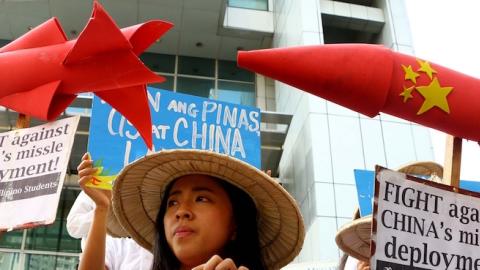Secretary of State John Kerry is maintaining the rage with respect to reports surfacing last week that China had installed several missile batteries on Woody Island, part of the disputed Paracel Island chain. The revelation emerged at the same time President Barack Obama was hosting Association of Southeast Asian Nations leaders in Rancho Mirage, California causing embarrassment for the White House. In Asia, the standard reaction has been to urge calm and restraint on all sides even if alarm in regional capitals is palpable.
This is unfortunate. A diplomat’s response – taking the heat out of an issue – is not always the same thing as good strategy. Winston Churchill once told us to never let a good crisis go to waste. Chinese missiles on Woody Island is far from a full blown crisis. But America should shelve diplomatic instincts, heed Churchill’s advice, and encourage allies and partners to do the same.
Beijing’s so-called salami slicing approach in the South China Sea is well known: adopt the diplomat’s language emphasising restraint and dialogue; indefinitely delay or frustrate any meaningful agreement that imposes limits on behaviour, such as the China-ASEAN Code of Conduct; and extend its de facto control and influence throughout disputed areas in incremental ways such that each individual action is never provocative enough to justify firm counter-measures against China by America and regional powers. Hence the impossibility for America to define and draw military red-lines with respect to Chinese actions.
This approach has been successful beyond even what China might have hoped for several years ago. Since 2013, Beijing has built artificial islands in disputed regions well in excess of 2,000 acres. If American officials are honest, China’s ‘progress’ in this context meets the definition of what White House advisers would have termed the worst-case scenario when the Obama administration gain office in 2009. Now that the proverbial horse has bolted, the question is what one can do about it.
We are still some distance away from the need for a military response or solution, and it would mean collective failure of American leadership and the region if it came to that. The key is to force China to more seriously consider the non-military costs of its actions than it has had to do up to now.
Beijing has cleverly avoided the overt militarisation of South China Sea disputes through use of fishing vessels, coast guards and other para-military entities to advance national maritime claims in the region. Only very rarely has the People’s Liberation Army Navy been involved. This is where the revelation of missile batteries on Woody Island can come into play for American and regional advantage.
The first step is for America and other countries to pursue an overtly public conversation into precisely when the missile batteries were placed on Woody Island. We know they were not there in pictures taken at the beginning of the month. So when exactly did the provocative action occur?
The conversation needs to be done in the spirit of a fact-finding inquiry rather than begin as an accusatory action. Maybe declare to China that we, in the words of Chinese reformer Deng Xiaoping, seeking truth from fact. If enough capitals are persistent enough, such a fact-finding mission will be difficult for Beijing to dismiss or ignore even if it is likely to try to do so.
The second step is to publicly look into why Beijing felt the need to install advanced missiles on Woody Island, and whether it intends to do so on other disputed land features. Once again, Beijing will have little enthusiasm when it comes to answering such questions. Yet, refusal to do so will only give rise to increasingly fervent regional speculation, some informed and others less so. For a country obsessed about preventing the emergence of explicit coalitions against its interests, allowing such speculation is hardly in China’s interest.
The point is to shape the region’s news cycle and public conversation in a way that will force Beijing to defend or else explain its actions in the South China Sea to as broad a regional audience as possible, and ensure such a conversation has a public shelf life beyond a few days as has been the case up to now with each instance when China pushes the envelope. Each instance of salami slicing in the South China Sea by Beijing needs to be discussed within a consistent narrative of how China intends to use its power and for what purpose. Since Chinese President Xi Jinping assured us last September that China will not militarize its claims in the South China Sea, why place some of its most advanced missiles on Woody Island?
Finally, putting public pressure on China will also place greater pressure on ASEAN countries such as Thailand, Cambodia and Laos to express a shared concern about Chinese behaviour, rather than do Beijing’s bidding by sitting on the sidelines and frustrating any collective measures by ASEAN and America in the process.
The Sunnylands Declaration issued at the conclusion of the U.S.-ASEAN Summit in California specifically affirmed resolving disputes according to existing international law and without resorting to militarisation to achieve one’s aims. China was not specifically mentioned.
If missiles on Woody Island is not a crisis, it is nevertheless an opportunity and ought not to be wasted.
















